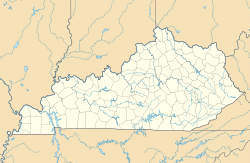Mitchell Building-First State Bank Building | |
 | |
| Location | 222 Knox St., Barbourville, Kentucky |
|---|---|
| Coordinates | 36°52′01″N83°53′12″W / 36.86694°N 83.88667°W |
| Area | 0.1 acres (0.040 ha) |
| Built | 1910 |
| Built by | Ed Dishman |
| Architect | Ed Dishman |
| Architectural style | Romanesque Revival |
| NRHP reference No. | 84002751 [1] |
| Added to NRHP | August 1, 1984 |
The Mitchell Building-First State Bank Building, at 222 Knox Street in Barbourville, Kentucky, is a Romanesque Revival-style building built in 1910. It was listed on the National Register of Historic Places in 1984. [1]
It is a three-story masonry wall and wood-frame building, with a Romanesque brick arch entry as its most salient feature. The brickwork is in common bond with a quoin detail every sixth course. It was designed and built by Ed Dishman. [2]
It was deemed notable as "the best example of the Romanesque Revival style in Barbourville." [2]

